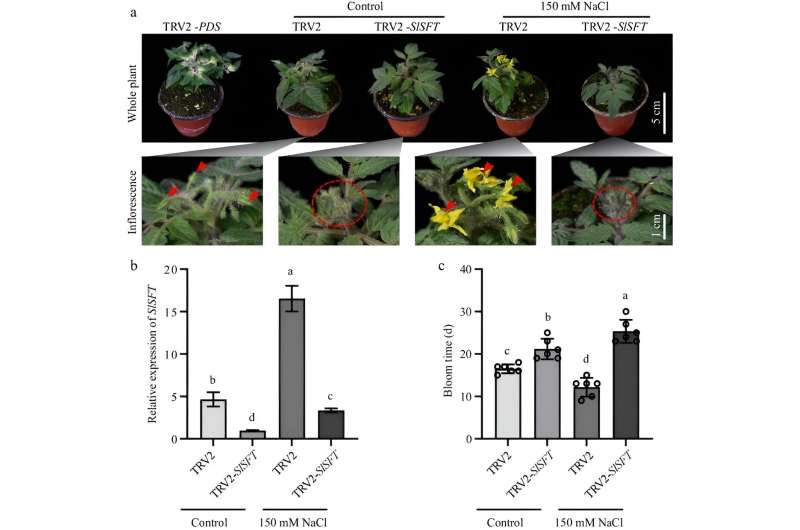This article has been reviewed according to Science X's editorial process and policies. Editors have highlighted the following attributes while ensuring the content's credibility:
fact-checked
trusted source
proofread
Salt stress promotes early flowering, inhibits floral organ development by disturbing cell cycle in tomatoes

A research team investigated the impact of salt stress on tomato (Solanum lycopersicum) floral transition, revealing that salt stress significantly reduced plant biomass and caused early flowering and smaller flowers. This study underscores the importance of understanding salt stress effects on crops, as it highlights how moderate salt stress can accelerate flowering by upregulating the SINGLE-FLOWER TRUSS (SFT) gene.
These findings hold the potential for improving tomato production in saline-alkali soils, offering insights into managing crop yield under adverse environmental conditions.
Plants, being inherently sessile, have evolved mechanisms to sense environmental changes, which are crucial for their production. Current research indicates that these mechanisms influence flowering time, essential for reproductive success and seed production. However, under abiotic stress, plants adjust flowering time, which can either be promoted or inhibited.
Salinity, as a significant stress factor, can disrupt flowering timing and fertility in plants. The FA and SFT in tomatoes are homologous genes of LEAFY (LFY) and FLOWERING LOCUS T (FT) in Arabidopsis, respectively, and play parallel roles in flowering regulation.
Research has shown that FT and its homologous genes may be involved in the flowering process of plants under abiotic stress. Despite extensive studies, the precise impact of salt stress on the transition from vegetative to reproductive growth in tomatoes remains unclear, necessitating further investigation into these mechanisms.
A study published in Vegetable Research on 27 June 2024, aims to understand the mechanisms behind salt-induced early flowering in tomatoes.
In this study, researchers investigated the effects of salt stress on tomato flowering time by treating "Micro Tom" seedlings with varying concentrations of NaCl solutions and recording the days to first flowering. The results indicated that salt stress significantly altered the flowering time, with lower concentrations (50–150 mM NaCl) inducing flowering and higher concentrations (200 mM NaCl) inhibiting it.
Additionally, higher concentrations of salt stress reduced the number of flowers and sprays per seedling, indicating disrupted physiological processes and reduced biomass accumulation.
To explore the underlying mechanisms, RT-qPCR was used to measure the expression levels of key flowering genes (SlSFT and SlFA), revealing that SlSFT expression correlated with early flowering under salt stress. Silencing SlSFT in tomato plants confirmed its role in salt-induced early flowering, as these plants did not flower early under salt treatment. Furthermore, salt stress impacted the cell cycle progression in floral organs, particularly sepals and petals, leading to reduced organ size and altered morphology.
Cyclin gene expression analysis indicated that salt stress hindered the G2/M checkpoint, causing significant morphological changes. Ultimately, salt stress resulted in reduced yield due to smaller fruit size, although the total number of fruits remained unchanged. Clustering and PCA analyses underscored the dosage-dependent nature of salt stress on flowering time.
According to the study's lead researcher, Fangfang Ma, "Our study elucidates that salt stress promotes early flowering by inducing SFT expression and retards tomato floral organ development via perturbation of the cell cycle."
In summary, this study investigated the impact of salt stress on tomato flowering, revealing that NaCl concentrations of 50–150 mM induced early flowering and reduced biomass. RT-qPCR showed upregulation of the SFT gene, activating the SFT-AP1 pathway.
Salt stress has a significant impact on the replication of tomato sepals and petal kernels, and can disrupt the cell cycle in floral organs. Future research should focus on manipulating genes like SFT to enhance crop resilience and productivity on saline-alkali lands.
More information: Fengze Sun et al, Salt stress induces SFT expression to promote early flowering and inhibits floral organ development by disturbing cell cycle in tomato, Vegetable Research (2024). DOI: 10.48130/vegres-0024-0017
Provided by Chinese Academy of Sciences




















